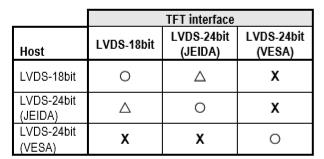TFT LCD LVDS Interfaces & Colors
LVDS is one of the main interfaces of TFT LCD display module. It has faster data transfer and lower power consumption than other interfaces. There is an article about LVDS interface. This time we chat about display color issue caused by interface protocols miss-match.
Background
1. Related Product: TFT LCD display modules with LVDS interface.
2. The definition of LVDS signal
- LVDS full name is Low Voltage Differential Signal.
- LVDS TFT LCD display modules require packed RGB data signal and sync signal as input by using 4 or 5 pairs wires.
3. Type of LVDS display interface signal
4. Matching host and LVDS TFT display module
- There are mainly three common types of LVDS interface
- 18bit, 24bit(JEIDA) and 24bit(VESA) LVDS.
- Their packed RGB data signal and sync format are not the same.
![]()
*1. R5, G5 & B5 are the MSB of color data
*2. R7, G7 & B7 are the MSB of color data

○=Normal; △=limited to 18bit color; X=abnormal color
Q&A
1. After system booted up, the texts on screen are normal. But the screen shows messy color. What is happenning on the display?
- As screen showing text is in black and white mode, it may display well even the interfaces are miss-matched. But not for color, it is highly possible causing by the LVDS interface type matching problem. Please recheck the host interface type and TFT interface type in their specifications.
2. How to tell whether it is a kind of LVDS interface miss-matched issue?
- Since different type of LVDS signal packing the RGB data in different ways, showing a gray level bar on the display will help you see the issue easily. (Please refer to Appendix for possible result)

3. When LVDS interfaces are miss-matched, is it possible to swap some of the interface pairs to make it work?
- No! The RGB data is packed differently, switching cables won't help.
4. Can I use a 24bit-LVDS(JEIDA) TFT LCD display module with a 18bit-LVDS host board?
- Yes, it can work. You just need to leave the IN3+ and IN3- opened and connect the others. (Please, refer to their specification for details) As the 18bit-LVDS signal cannot tell the TFT display to show a “full white(FFFFFF)”, the highest white level will be ”FCFCFC”.
5. Can I use a 18bit-LVDS TFT LCD display module with a 24bit-LVDS(JEIDA) host board?
- Yes, it can work well. Leaving the IN3+ and IN3- opened and connecting the others will make it work. (Please, refer to their specification for details).
(Note, 18bit LVDS TFT display module only can show 18bit color depth)
6.The system is working properly, but the display is very dim. Is there any thing wrong?
- Check the backlight power supply. There may be a “low-level” PWM given to the TFT display module which dims the backlight brightness . Or the PWM active level is reversed. Also, it could be wrongly feeding a 18bit LVDS data to a 24bit-LVDS(VESA) TFT display module . (see Appendix) Some of Topway's TFT display modules have interface selection setting. It might be wrongly wired. (Pls, refer to their specification for details)
Conclusion
Understanding how LVDS interface interoperately works with each other will save you a lot of time during implementation. Leave us a message if you need LVDS assistant.
Appendix
1. Wrongly feed 24bit-LVDS(JEIDA) signal to 24bit-LVDS(VESA) TFT Display Module.
2.Wrongly feed 24bit-LVDS(VESA) signal to 24bit-LVDS(JEIDA) TFT Display Module.


3. Wrongly feed 24bit-LVDS(VESA) signal to 18bit-LVDS TFT Display Module.
4. Wrongly feed 18bit-LVDS signal to 24bit-LVDS(VESA) TFT Display Module.


